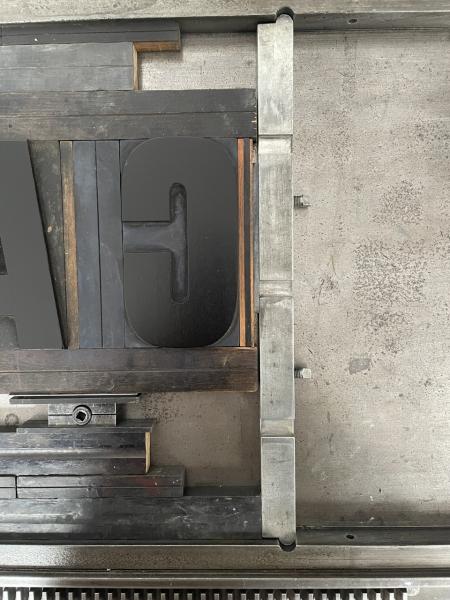Smears near the edge
Hi All
Any idea what’s causing/how I can eliminate the smears I’m getting near at the end of my sheet please?
Im printing on a vandercook 4 with a sheet size of 500x370mm
Any ideas gratefully received. Thank you

010C8A66-BF50-4F97-A112-D68F91F2034A.jpeg

54149BC8-8CC4-40B7-B689-0A2BFBB08BFA.jpeg
Ah…removing the paper tray that sits behind the rollers seems to have cured it
FFS no it didn’t …
Your marks and smear are at the tail edge of your sheet.
Suggest you hold the sheet down with left hand as it moves with the cylinder. That will prevent the sheet backlash.
Michael
The end of your paper is likely flopping down and hitting the trailing edge of the type. Press points are great for this- they’ll hold the last bit of paper up away from the type. If you can’t find any, someone taught me the trick of taking a 5 pica wide piece of furniture, stand it on its side, and use it at the end of your lock up in place of press points, it should be just under type high and hold up the end of the paper a bit. If none of this works you can put repositionable double stick tape on the cylinder to hold the paper against the cylinder the whole way, as long as you’re careful taking the paper off.
(Check the width of the 5 pica furniture before you use it, I’m not in the shop to measure and might be remembering the wrong size. )
They used to make these points to help with slurring. Here is a picture of an ad from an old 1950s Graphic Arts Monthly. Pretty nice price. But that is what they look like in case some printers have them in their possession but don’t know what they are for.
-Bob
steelpoints.jpg
alistair,
Here is an example of holding the sheet against the cylinder on a Vandercook No. 4
https://youtu.be/8OkqDRJu8W8
Michael
It looks like you’d have to have a much longer sheet if you hope to prevent “tail slap” after releasing the sheet as the print progresses. You might try using a bit of masking tape at the tail edge, although that requires removing it prior to returning the cylinder as you remove the sheet at the end of the impression. I have used the points mentioned, but anything close to type high (so it remains uninked) can help you with this problem.
John Henry
Cedar Creek Press
With a long sheet and close to the end I’ll put a small piece of double-stick tape on the cylinder to adhere the sheet to so it doesn’t flop on the form. It’s always worked for me.
Casey
Inky Lips Press
The text of the advertisement posted by Pressrun is interesting. I hadn’t heard of “press brush” before. I can guess the timing it refers to but what exactly is “press brush”?
Roger
The Tuatara Press
The text of the advertisement posted by Pressrun is interesting. I hadn’t heard of “press brush” before. I can guess the timing it refers to but what exactly is “press brush”?
Roger
The Tuatara Press
The text of the advertisement posted by Pressrun is interesting. I hadn’t heard of “press brush” before. I can guess the timing it refers to but what exactly is “press brush”?
Roger
The Tuatara Press
On a traditional cylinder press, such as a Kelly, Miller, Heidelberg or a Miehle (including the Vertical), the press had an inset brush to smash the air out from under the sheet and to keep the sheet end against the cylinder. This prevents to a large extent the “tail slap” against the rear edge of the form. The brush was held in place by screws, clips, or some other method of fastening and adjusting it for various differences in weights of stock, as well as removing the assembly for cleaning.
Another thing that might cause tail slur is having the stock cut so that the grain goes around the cylinder — especially on thicker stocks. On those, if it is possible, have the grain to run parallel to the axis of the cylinder; it will improve the handling greatly.
Just Keep Printing!
Frank.